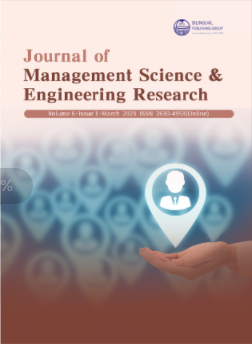-
5451
-
914
-
425
-
400
-
389
Analysis of Simple Additive Weighting Method (SAW) as a MultiAttribute Decision-Making Technique: A Step-by-Step Guide
DOI:
https://doi.org/10.30564/jmser.v6i1.5400Abstract
The simple additive weighting (SAW) method is one of the oldest and most widely used decision-making methods. It has a simple process that can be utilized in different subject areas such as engineering, environmental sciences, and energy. The main concepts of the SAW method are introduced in this paper and then a step-by-step guide to using SAW technique for decision-making and ranking purposes in multi-attribute cases is presented.
References
[1] Taherdoost, H., 2017. Decision making using the Analytic Hierarchy Process (AHP): A step by step approach. International Journal of Economics and Management Systems. 2, 244-246.
[2] Taherdoost, H., Madanchian, M., 2020. Prioritization of leadership effectiveness dimensions improving organizational performance via Analytical Hierarchy Process (AHP) technique: A case study for Malaysia's digital service SMEs. Digital Transformation and Innovative Services for Business and Learning. IGI Global: USA. pp. 1-21.
[3] Memariani, A., Amini, A., Alinezhad, A., 2009. Sensitivity analysis of simple additive weighting method (SAW): The results of change in the weight of one attribute on the final ranking of alternatives. Journal of Industrial Engineering. 4, 13-18.
[4] Sari, K., Suslu, M., 2018. A modeling approach for evaluating green performance of a hotel supply chain. Technological Forecasting and Social Change. 137, 53-60.
[5] Podvezko, V., 2011. The comparative analysis of MCDA methods SAW and COPRAS. Engineering Economics. 22(2), 134-146.
[6] Qin, X.S., Huang, G.H., Chakma, A., et al., 2008. A MCDM-based expert system for climate-change impact assessment and adaptation planning–A case study for the Georgia Basin, Canada. Expert Systems with Applications. 34(3), 2164-2179.
[7] Irawan, Y., 2020. Decision support system for employee bonus determination with web-based Simple Additive Weighting (SAW) method in PT. Mayatama Solusindo. Journal of Applied Engineering and Technological Science (JAETS). 2(1), 7-13.
[8] Hamid, A., Sudrajat, A., Kawangit, R.M., et al., 2018. Determining basic food quality using SAW. International Journal of Engineering and Technology (UAE). 7(4), 3548-3555.
[9] Velasquez, M., Hester, P.T., 2013. An analysis of multi-criteria decision making methods. International Journal of Operations Research. 10(2), 56-66.
[10] Pramanik, P.K.D., Biswas, S., Pal, S., et al., 2021. A comparative analysis of multi-criteria decision-making methods for resource selection in mobile crowd computing. Symmetry. 13(9), 1713.
[11] Sembiring, B.S.B., Zarlis, M., Sawaluddin, et al., 2019. Comparison of SMART and SAW Methods in Decision Making. Journal of Physics: Conference Series. 1255, 012095.
[12] Wardana, B., Habibi, R., Saputra, M.H.K., 2020. Comparation of SAW method and topsis in assesing the best area using HSE standards. EMITTER International Journal of Engineering Technology. 8(1), 126-139.
[13] Pranolo, A., Widyastuti, S.M. (editors), 2014. Simple additive weighting method on intelligent agent for urban forest health monitoring. 2014 International Conference on Computer, Control, Informatics and Its Applications (Ic3Ina); 2014 Oct 21-23; Bandung, Indonesia. IEEE: USA. p. 132-135.
[14] Ginevicius, R., Podvezko, V., 2007. Some problems of evaluating multicriteria decision methods. International Journal of Management and Decision Making. 8(5-6), 527-539.
Downloads
How to Cite
Issue
Article Type
License
Copyright © 2023 Author(s)

This is an open access article under the Creative Commons Attribution-NonCommercial 4.0 International (CC BY-NC 4.0) License.




 Hamed Taherdoost
Hamed Taherdoost





